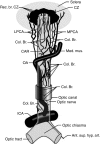Perioperative visual loss: what do we know, what can we do?
- PMID: 20007988
- PMCID: PMC2791856
- DOI: 10.1093/bja/aep295
Perioperative visual loss: what do we know, what can we do?
Abstract
Perioperative visual loss (POVL), a rare, but devastating complication, can follow non-ocular surgery. Highest rates of visual loss are with cardiac and spine surgery. The main causes of visual loss after non-ocular surgery are retinal vascular occlusion and ischaemic optic neuropathy. This review updates readers on the incidence, suspected risk factors, diagnosis, and treatment of POVL due to these conditions.
Figures


References
-
- Alexandrakis G, Lam BL. Bilateral posterior ischaemic optic neuropathy after spinal surgery. Am J Ophthalmol. 1999;127:354–5. - PubMed
-
- Alm A, Bill A. Ocular circulation. In: Moses A, Hart C, editors. Adler's Physiology of the Eye. St Louis: CV Mosby; 1987. pp. 183–203.
-
- Anonymous. Practice Guidelines for blood component therapy: a report by the American Society of Anaesthesiogists Task Force on Blood Component Therapy. Anesthesiology. 1996;84:732–47. - PubMed
-
- Arens JF, Connis RT, Domino KB, et al. Practice advisory for perioperative visual loss associated with spine surgery. A report by the American Society of Anaesthesiologists Task Force on Perioperative Blindness. Anesthesiology. 2006;104:1319–28. - PubMed
-
- Arnold AC. Pathogenesis of nonarteritic anterior ischaemic optic neuropathy. J Neuroophthalmol. 2003;23:157–63. - PubMed
Publication types
MeSH terms
Grants and funding
LinkOut - more resources
Full Text Sources
Medical

